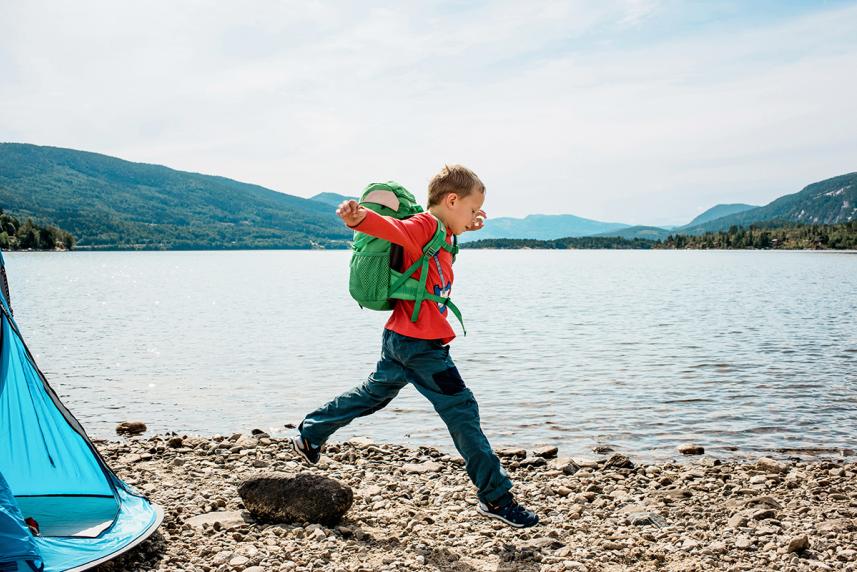
We have more than 60,000 doctors at over 2,000 locations. Our team will help you get the care you need, when and where you need it.

Ready to head into nature? We’ve got everything you need to make sure your day is full of fun and adventure.
There’s no shortage of wonders when you’re out in the woods. Impossibly tall trees. Tiny wildflowers. Light that looks full of magic. Just the views alone may lift your mood being out there.
“Fresh air, sunshine and enjoying nature are good for your mind and body,” says Matthew McGlothlin, MD. He’s the senior medical director at WellMed Medical Management, part of Optum, in San Antonio. And you can reap the benefits of being outdoors whether you’re on an afternoon hike or a weeklong camping trip.
But being out in nature comes with, well, nature. Stinging insects. Bumpy trails. Poisonous plants. They may be there with you, but they don’t have to ruin your fun. Here’s how.
Bug bites are itchy and can hurt. And some can make you sick. So it’s 100% worth the effort to protect yourself.
“Use a spray with DEET to keep bugs away,” says Dr. McGlothlin. The Environmental Protection Agency has approved using DEET for all ages.1 Two possible exceptions are pregnant women and infants younger than 2 months old.2,3 Ask your doctor about what’s right for you.
Other great ways to protect yourself from bugs:
If you still get nabbed by mosquitoes, here’s what to do4:
And try, try, try not to scratch. You’ll help reduce swelling, itching and the chance of an infection. (An infection is an illness caused by germs.)
If the temperature is soaring, you’ll want to be extra careful about intense activity. If not, you could set yourself up for a heat illness such as heat exhaustion or even heatstroke.
“Heat-related conditions vary in intensity,” says Dr. McGlothlin. Often, you’ll first notice heat cramps (or muscle pains) as you exercise. As you sweat, your body loses salt and fluids. You can quickly develop heat exhaustion. That’s when your body can no longer cool itself through sweating alone. If heat exhaustion goes untreated, it can progress to heatstroke. This severe illness can lead to seizures, coma and organ damage.5
That sounds scary, but it’s something you can prevent by drinking enough water. How much? Dr. McGlothlin recommends “preloading.” Start drinking several hours before you head out. That will help ensure that you’re well hydrated from the start.
If you’ll be walking hard, aim for about a quart of water an hour. If you’re taking it easier, the eight-glasses-a day rule should keep you covered, he says. Steer clear of caffeine and alcohol, though. They can make you lose more water.
And if you see a stream or lake along the way, take a quick dip for an instant cool-down.

We have more than 60,000 doctors at over 2,000 locations. Our team will help you get the care you need, when and where you need it.
Pokey branches. Slippery rocks. Trip-inducing tree roots. You’ve got to keep your eyes open and your feet steady when you’re out there.
To lower the odds of a gash, take your time and watch where you’re going. Keep sharp gear like pocketknives securely tucked away when not in use. And stick to well-worn hiking trails, where you’re less likely to slip and fall.
If you do take a tumble, caring for minor cuts and scrapes is pretty simple.
For deep wounds that don’t stop bleeding after about five minutes of direct pressure, call 911. That’s the recommendation of the American College of Emergency Physicians.6 While you wait for medical help to arrive, continue pressing on the wound. Add more cloth or bandages if needed. If bleeding is severe, wrap a 3-inch-wide band or belt (tourniquet) above the wound and pull tightly.
Poison ivy, poison oak and poison sumac all secrete an oil called urushiol. If the oil gets on your skin, you can expect an itchy, red and blistery rash. If you’ve inhaled smoke from a burning poisonous plant, you may have difficulty breathing. Seek emergency help right away if that happens.
The best way to prevent a rash from a poisonous plant is to know how to spot one. Stay on the trail and don’t pick leaves.
If you accidentally swish through a patch of poison ivy, oak or sumac? Wash your skin as soon as possible. Then wash any clothes or equipment that may also have come in contact with the plant. These items can spread the oil to other parts of your body. If you can, wear gloves while removing clothes and washing items.
If you develop a rash, take short, lukewarm baths. Use calamine or over-the-counter hydrocortisone creams. Cool compresses can also help with itching, says Dr. McGlothlin. “Also, don’t scratch or pop any blisters,” he adds. “It can lead to infection.”
The rash typically goes away in two to three weeks. But if it’s severe, you may need prescription medication to reduce swelling.
Use this checklist from the American Red Cross to build your kit.7 Plus, you can use your HSA/FSA funds to save even more.
You can stock up on all your first-aid supplies at the Optum Store. Start shopping now.
Sources
© 2022 Optum, Inc. All rights reserved. Do not reproduce, transmit or modify any information or content on this website in any form or by any means without the express written permission of Optum.
The information featured in this site is general in nature. The site provides health information designed to complement your personal health management. It does not provide medical advice or health services and is not meant to replace professional advice or imply coverage of specific clinical services or products. The inclusion of links to other web sites does not imply any endorsement of the material on such websites.
Stock photo. Posed by model.